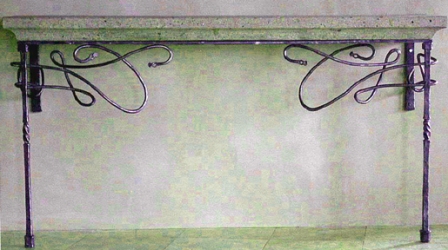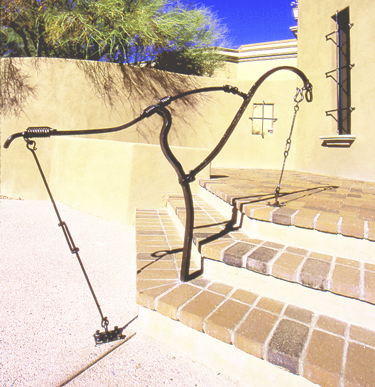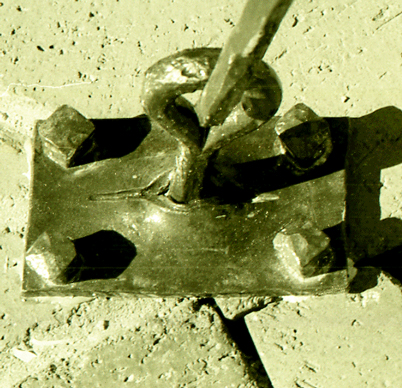I never painted iron work before except for a clear protective lacquer to preserve the natural color of the steel. And I was not in favor of it at first, but then too I had a bias against colored sculpture until I saw “Border Crossing” by the late Luis Jimenez one day in Santa Fe. It destroyed all biases because it is a finer work than Michelangelo’s “Pieta.” I’m saying I’ll paint ironwork any day.
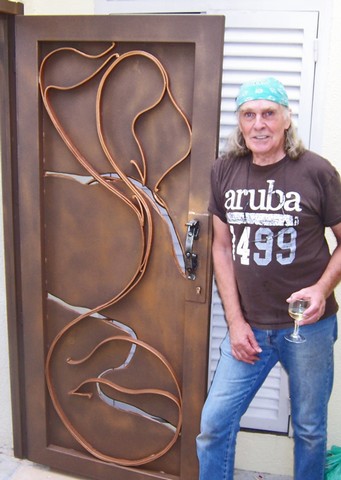
I did this front design first and forged the elements. Our friend and neighbor, Aquilino de Gois, had his people fabricate the base and frame and do the installation. We searched Caracas for six weeks and finally found the exact color paint in Miami. It took two months to get one gallon of the base and three spray cans for accents to get here.
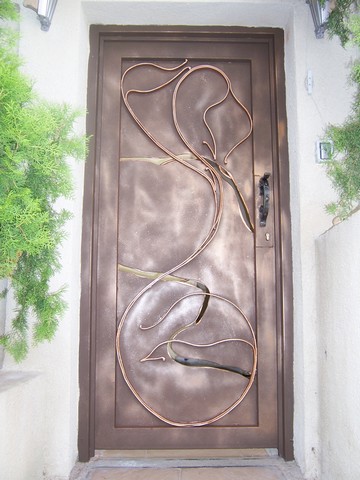
This is the male side, the outside. It is in relief, solid.
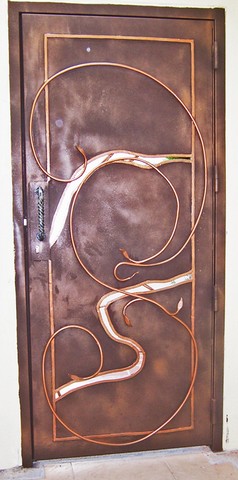
This is the inside…female, sinuous, hardly ever touching and can’t always stay inside the lines.
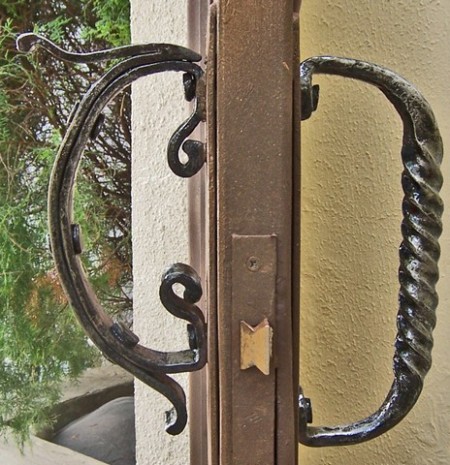
Male and female handles, coiling in, pushing out. I like the more detailed outside handle because it recalls bits and piece of forgotten ironwork in the old streets of Florence…stuff no one ever sees any more unless they have magnets in their blood.
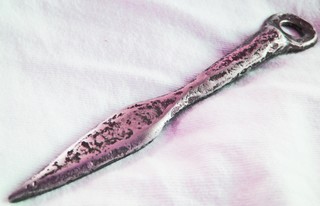

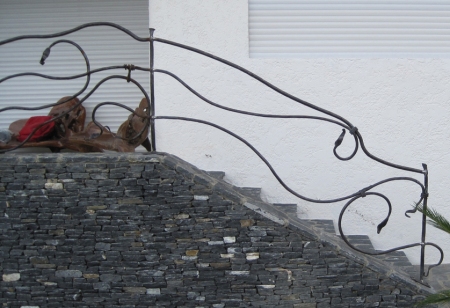




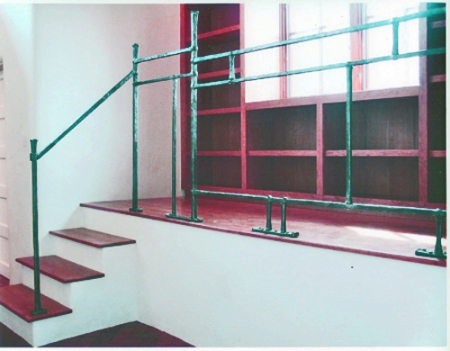 First of all: The distance between the floor of the room and the floor of the bookcase balcony just happened to be 29.5 inches (0.75 meters)—half an inch higher and all openings in the rail would have to be 4 inches (10 centimeters) or less. And everything else (except for the little hand rail going up the steps) is based on the
First of all: The distance between the floor of the room and the floor of the bookcase balcony just happened to be 29.5 inches (0.75 meters)—half an inch higher and all openings in the rail would have to be 4 inches (10 centimeters) or less. And everything else (except for the little hand rail going up the steps) is based on the 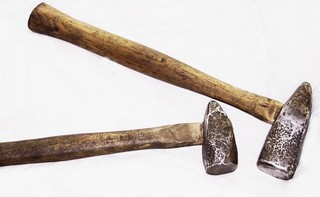 When I first came to South America all I could find by way of hammers was one standard issue 2.5 lb. Ridgid with a cross pein that can double as a cold chisel. But it worked well enough to help forge both of these from a 2” bolt of tool steel that was probably scrapped out from a Venezuelan oil field and sold to me for about 18 cents a lb. (U.S.$). Because I lacked a good tempering block and I’ll be damned if I’d stoop to using a torch, both turned out to be perfectly tempered using the reserve heat process and a couple of fairly well educated guesses as to timing. They were annealed and then slowly brought to a uniform cherry red heat. Then I quenched them in 50 wt. motor oil until I decided to take them out. Then I waited a little until they were uniformly colored again and quenched them in water just to a barely black heat on their surfaces. Next I pulled them from the water, thought about it a little and quenched them again until cool. I have been using them for about five years and their faces are as good as the first day they went to work. The little one lives on the vice post and the big one on the anvil. I don’t know, nor really care, how much they weigh, but its enough. The little Ridgid can be seen below as Vladimir, my striker (golpeador to him), and I start to pierce the handle eye in the larger piece.
When I first came to South America all I could find by way of hammers was one standard issue 2.5 lb. Ridgid with a cross pein that can double as a cold chisel. But it worked well enough to help forge both of these from a 2” bolt of tool steel that was probably scrapped out from a Venezuelan oil field and sold to me for about 18 cents a lb. (U.S.$). Because I lacked a good tempering block and I’ll be damned if I’d stoop to using a torch, both turned out to be perfectly tempered using the reserve heat process and a couple of fairly well educated guesses as to timing. They were annealed and then slowly brought to a uniform cherry red heat. Then I quenched them in 50 wt. motor oil until I decided to take them out. Then I waited a little until they were uniformly colored again and quenched them in water just to a barely black heat on their surfaces. Next I pulled them from the water, thought about it a little and quenched them again until cool. I have been using them for about five years and their faces are as good as the first day they went to work. The little one lives on the vice post and the big one on the anvil. I don’t know, nor really care, how much they weigh, but its enough. The little Ridgid can be seen below as Vladimir, my striker (golpeador to him), and I start to pierce the handle eye in the larger piece. 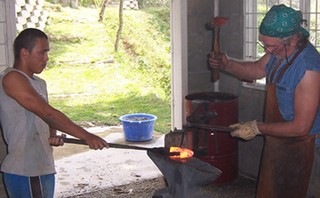 I’ve been around long enough to have grown fairly cynical about all occupational cultures. Making one’s own hammers might seem high-order Blacksmithing to some, but to me its a waste of time and fuel unless one can’t find what they need in a store. After all a hammer is just a chunk of steel on the end of a stick and hardly worthy of being named or dedicated or baptized and christened Conan or Mildred or made the object of any other kind of sentimental and romantic nonsense. And they don’t have to be pretty or polished or shapely. All that is needed is heavy and hard enough. In the late 90’s I rented a corner of Frank Turley’s forge in Santa Fe, NM, U.S.A. and one day during one of Frank’s class sessions, Tom Joyce brought Uri Hoffi, the apparently world class Israeli smith, around to show a few tricks; like he forged a screw driver with an overhand knot tied in the shaft. But what I found fascinating was his stylish little short handled hammer that he gripped near the head. While I cut him all the slack I could find laying around because his health was poor and years were many, I couldn’t help but think that here was a man who never got the chance to learn how to play baseball, never learned to hold a bat full length and swing for the fence, or never learned how to hold racket for a truly uncivilized game of tennis. He never learned how to do any of that and all the tricks needed to keep his body healthy and whole as well. So he had developed a striking technique that was a perfect imitation of how Walter Brennan used to hobble through The Real McCoys. I was amazed, still am, but nonetheless that big, ugly hammer has a 15” handle that I hold at full length and swing for the fence every chance I get. Don’t misunderstand here and think the Anti Hoffi hammer style means that I am against his pattern—whatever piece of steel on the end of a stick turns out the work is the one to use. It is just that my two are on the far end of the hammer spectrum from his, sort of polar opposites like Christ and Anti Christ, which seems like an apt analogy since Uri and Jesus hopefully enjoyed the fruits of a common culture that is not one I could call mine. I grew up on ranches in Wyoming.
I’ve been around long enough to have grown fairly cynical about all occupational cultures. Making one’s own hammers might seem high-order Blacksmithing to some, but to me its a waste of time and fuel unless one can’t find what they need in a store. After all a hammer is just a chunk of steel on the end of a stick and hardly worthy of being named or dedicated or baptized and christened Conan or Mildred or made the object of any other kind of sentimental and romantic nonsense. And they don’t have to be pretty or polished or shapely. All that is needed is heavy and hard enough. In the late 90’s I rented a corner of Frank Turley’s forge in Santa Fe, NM, U.S.A. and one day during one of Frank’s class sessions, Tom Joyce brought Uri Hoffi, the apparently world class Israeli smith, around to show a few tricks; like he forged a screw driver with an overhand knot tied in the shaft. But what I found fascinating was his stylish little short handled hammer that he gripped near the head. While I cut him all the slack I could find laying around because his health was poor and years were many, I couldn’t help but think that here was a man who never got the chance to learn how to play baseball, never learned to hold a bat full length and swing for the fence, or never learned how to hold racket for a truly uncivilized game of tennis. He never learned how to do any of that and all the tricks needed to keep his body healthy and whole as well. So he had developed a striking technique that was a perfect imitation of how Walter Brennan used to hobble through The Real McCoys. I was amazed, still am, but nonetheless that big, ugly hammer has a 15” handle that I hold at full length and swing for the fence every chance I get. Don’t misunderstand here and think the Anti Hoffi hammer style means that I am against his pattern—whatever piece of steel on the end of a stick turns out the work is the one to use. It is just that my two are on the far end of the hammer spectrum from his, sort of polar opposites like Christ and Anti Christ, which seems like an apt analogy since Uri and Jesus hopefully enjoyed the fruits of a common culture that is not one I could call mine. I grew up on ranches in Wyoming.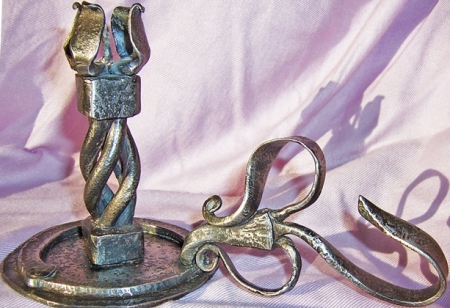

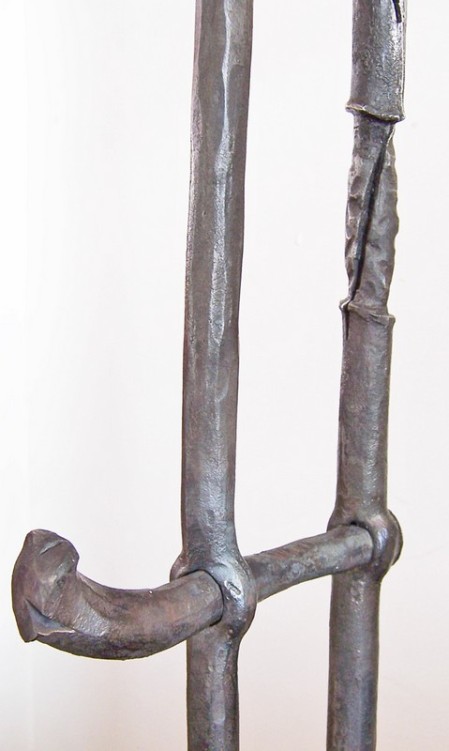

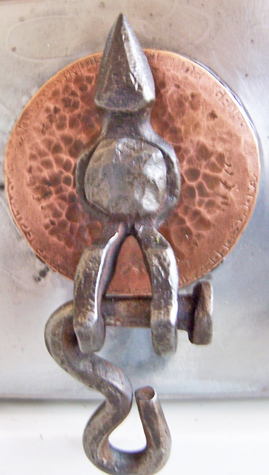 Here in the slowly developing world the plastic oven dials will never outlive the appliance especially if the mechanism tends to balk shutting off when hot. And like car parts in Cuba, replacement hardware for stoves in Vla. is somewhat hard to find. So I forged this little piece to survive whoever might own it, survive the land-fill when the time comes.
Here in the slowly developing world the plastic oven dials will never outlive the appliance especially if the mechanism tends to balk shutting off when hot. And like car parts in Cuba, replacement hardware for stoves in Vla. is somewhat hard to find. So I forged this little piece to survive whoever might own it, survive the land-fill when the time comes.